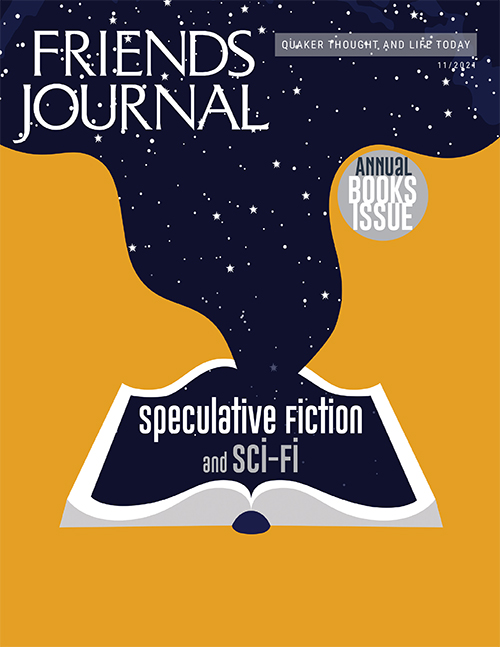Re-examining our histories
Francis G. Hutchins wrote an interesting article about Fox’s, Penn’s, and Franklin’s attitudes toward Native Americans (“Neighbors or Tenants?” FJ Oct.). The Hicks painting is misleading. And I love The Peaceable Kingdom.
Pat Dareneau
Hampstead, N.C.
I hope this corrected version of events will spread throughout the Quaker world.
One quibble: Hutchins says, “Hicksite Quakers are justly admired for their efforts to abolish slavery and end racist abuse of tribes.” Here in Ohio, much of the anti-slavery work was done by so-called Orthodox Quakers, the most well-known being Levi and Catherine Coffin, who worked alongside Presbyterians and Hicksite Quakers on the Underground Railroad. After the Civil War, President Grant appointed Quakers, many of them Orthodox Friends, as tribal agents to counter mistreatment of Indigenous people by military agents.
Donne Hayden
Cincinnati, Ohio
Crime and punishment, reconciliation and grief
I am so moved by Heather Lavelle’s writing (“Prison as Exile,” FJ Sept.). Thank you for bringing more light to the plight of women in prison who are struggling with their pasts, struggling with self-acceptance, and struggling with recovery in an environment that is not really conducive to recovery. You have clearly done much to help your fellow prisoners, and I know you have done much to help the understanding of those who are fortunate enough never to have been incarcerated. My thoughts and prayers are with you as you continue to work for release.
Kathryn E. McCreary
Orland, Calif.
While I’m glad this person is finding some peace and doing good works, it troubles me that in this article she doesn’t even mention her victim or his family, beyond a bare statement of the crime—and their eternal grief and their lost hope, and their lack of peace, and if she has shown any contrition outwardly and directly to them, and how this could or should play into her spiritual journey. She talks much about God and Jesus, but what about the Christian call to reconciliation? As Jesus says in Matthew 5:23–24, “If therefore you are offering your gift at the altar, and there remember that your brother has anything against you, leave your gift there before the altar, and go your way. First be reconciled to your brother, and then come and offer your gift.” Has this writer reached out to her victim’s brothers and sisters? Has she ever apologized? Has she asked them if there’s anything she can do to ease their agony? Wouldn’t that also bring her peace and perhaps them as well? I looked up her crime and it was absolutely horrible. Her victim’s family daily has to remember that he died in utter terror and excruciating pain. If she feels her punishment is just, is she willing to give up appeals or parole hearings? It just seems to me that this article is self-centered and self-serving.
Leto Lethe
Baltimore, Md.
I was the temporary associate editor at Friends Journal over the summer, and I worked closely with Heather Lavelle on this article. Just wanted to let you know that Heather has submitted a letter to the victim’s family, through the Inmate Apology Bank of the Pennsylvania Office of Victim Advocate. She is not able to reach out to the family in any other way, and also is not able to learn whether or not they’ve read her letter. All of this is deeply painful to her.
Joyce Hinnefeld
Bethlehem, Pa.
Heather Lavelle writes well. Her story is touching but not overly sentimental. I believe her!
Gaines Steer
Pittsboro, N.C.
Hope at Wounded Knee
I recently visited Pine Ridge and had a very different experience from Jeff Rasley (“Return to Wounded Knee,” FJ Oct.). The land is beautiful in a different way, and the Oglala people that I interacted with were welcoming in their own way. I suggest anyone in the area take a tour of the Red Cloud Indian School. Students are taught in immersive Lakota through elementary school and a mix of English and Lakota thereafter. The school has a 92 percent rate of graduates going on to college. Although the school is run by Catholics, students can choose to attend mass, sweat lodge, or both for their religious activities. You can buy beautiful art made by the students in the visitor center. The tribal government is encouraging tourism once COVID is under control. You can go online (or to Costco) and buy Tanka bars made from Buffalo meat and natural fruits. The bars are based on a Lakota recipe for pemmican and produced by an Oglala-owned company located on the reservation. While poverty and difficulties are one truth about Pine Ridge, there is so much more for those able to observe more deeply.
Bob Shively
Laporte, Colo.
More thoughts on Quaker mysticism
The word mystical puts me off (“The Mystical Experience” by Donald W. McCormick, FJ Aug.). I prefer transcendent because such experiences are greater than ordinary ones but they don’t necessarily signify that I have communicated with some higher power. This is the puzzle to me—why people assume their experience of connecting with a higher power means they have in fact done so. As an author and artist, I know that the experience of outside can come from inside. I see visions nightly in my dreams. I can be transported by sexual ecstasy or drugs or even exhaustion. Why do we see some prophet’s dream as some greater truth rather than just some personal trip that they enjoyed?
Chris King
Ojai, Calif.
I believe mystical experience is not meant to be mysteriously available only for a special few. It is meant to be commonplace and available to everyone—reinforced in meeting for worship and other gatherings but also available while washing dishes or pulling up weeds. The more experience I have, the fewer useful distinctions I can make. That state of being really is ineffable. Yet we need to talk about it in order to provide validation for folks who may not understand what is happening, or has happened, to them, and because we need to know that one’s spiritual experience can—and should—develop, grow, and change.
Sandra Palmer
Vienna, Va.
I have been engaged in the study of the actual relationship between Carl Jung and a group of Quakers who were in Geneva in the 1930s, and how they disseminated their transformed understanding of Quakerism as a mystical, experiential, and experimental religion that resulted.
The key members of that group, Irene Pickard, Elined Kotschnig (who played a leading role in the Friends Conference on Religion and Psychology), P. W. Martin (who wrote the book Experiment in Depth), and his wife, Margery, created an archive of materials, which Irene Pickard fortunately preserved.
They knew Rufus Jones, Howard Brinto,n and Douglas Steere, and like them, laid great stress on the mystical tradition within Quakerism, which for them was given extra zest by what they saw as the psychological underpinning provided by Jung. The resultant work is currently with a publisher.
D Lockyer
Milford Haven, UK
Friend McCormick speaks directly to my experience that I have rarely spoken to anyone about, precisely because it is so difficult to put into words. My unitive experiences always seemed outside mainstream Quakerism even though these experiences were a major part of the reason I continued returning to Quaker meetinghouses for the last 53 years. On those few occasions I attempted to explain my experience to another Friend, I felt misunderstood, rejected, or just ignored. But now Friend McCormick has provided the vocabulary.
Kristin K. Loken
Falling Waters, W.V.
As someone who considers himself a lifelong mystic, I believe mystical experiences exist on a spectrum—from “mind-blowing” transcendence to simple, brief mystical moments. Unfortunately, we tend to emphasize the former and under-value the latter.
For most of us, it takes having a daily practice to sensitize us to what Buddhists call “small satoris,” or the everyday varieties of awakening that show up while washing the dishes, for example.
The challenge, really, is to resist the urge to cling to our experiences of the mystical as if they are badges of achievement we can hang on the wall. They are not. Rather, they are deeply personal landmarks that remind us that Life, God, or the Universe is drawing us closer to itself.
Jim Birt
Danville, Pa.
There is something very powerful (and mystical) in the immediacy of silence and silent corporate worship. We carry the past with us in our memories, but a gathered meeting is also vitally present to the current moment and the experience of the Light within the world, within ourselves, within others. It is a direct encounter with the Spirit in which we have the opportunity for both theistic and unitive experiences!
David Castro
Bryn Mawr, Pa.




Comments on Friendsjournal.org may be used in the Forum of the print magazine and may be edited for length and clarity.